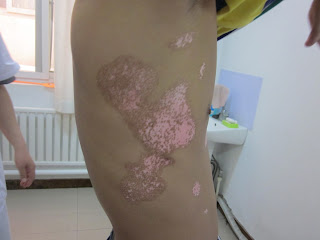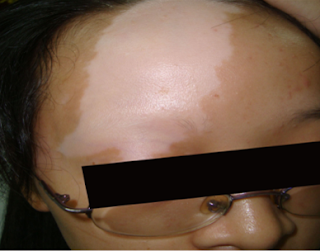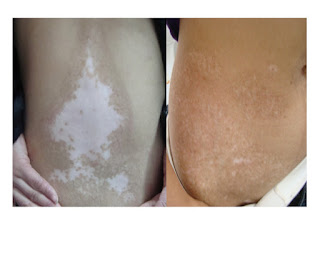How do dermatologists treat vitiligo?
If you have vitiligo, you should discuss treatment options with your
dermatologist. There are many treatment options. The goal of most treatments is
to restore lost skin color.
Here are some key facts about treatment options to help you start a
conversation with your dermatologist. The type of treatment that is best for you
will depend on your preference, overall health, age and where the vitiligo
appears on your body. Some people choose not to treat vitiligo.
1. No medical treatment (use cosmetics to add lost color):
Cosmetic options include makeup, a self-tanner and skin dye.
Offers safe way to make vitiligo less noticeable.
Often recommended for children because it avoids possible side effects from
medicine.
Drawbacks: Must be repeatedly applied, can be time-consuming, takes practice
to get natural-looking result.
2. Medicine applied to the skin:
Several different topical (applied to the skin) medicines can repigment the
skin.
Prescribed for small areas.
The most commonly prescribed medicine is a potent or super-potent topical
corticosteroid. About half, 45 percent, of patients regain at least some skin
color after 4 to 6 months.
A topical corticosteroid may be combined with another medicine to improve
results.
Topical medicine works best in people with darkly pigmented skin.
Topical medicines are most effective on certain areas of the body, such as
the face. They are least effective on the hands and feet.
Not all topical medicines should be used on the face.
Drawbacks: These medicines have possible side effects, so patients must be
carefully monitored. A possible serious side effect of using of a topical
corticosteroid for a year or longer is skin atrophy. This means the skin becomes
paper thin, very dry and fragile.
3. Light treatment for Vitiligo :
Uses light to repigment the skin.
Patient may sit in a light box or receive excimer laser treatments.
Light box used to treat widespread vitiligo; laser used to treat small
area.
Works best on the face; least effective on hands and feet.
Effective for many patients; about 70 percent see results with excimer
laser.
Results can disappear. About half, 44 percent, see results disappear within 1
year of stopping treatment. After 4 years, about 86 percent lose some color
restored by treatment.
May cause patients with darkly pigmented skin to see areas of darker skin
after treatment, but treated skin usually matches untreated skin within a few
months.
Requires a time commitment. Patients need 2 to 3 treatments per week for
several weeks.
May be combined with another treatment such as topical corticosteroid.
4. PUVA light therapy for vitiligo :
Uses UVA light and a medicine called psoralen to restore skin color.
Psoralen may be applied to the skin or taken as a pill.
Can treat widespread vitiligo.
About 50 percent to 75 percent effective in restoring pigment to the face,
trunk, upper arms and upper legs.
Not very effective for the hands or feet.
Time-consuming, requiring treatment at a hospital or PUVA center twice a week
for about 1 year.
Psoralen can affect the eyes, so this treatment requires eye exams before
starting treatment and after finishing treatment.
To help prevent serious side effects, patients need to be carefully
monitored.
Learn more Acupuncture can treat vitiligo
5. Surgery for Vitiligo:
May be an option when light therapy and medicines applied to the skin do not
work.
For adults whose vitiligo has been stable (not changed) for at least 6
months.
Not for children.
Not for people who scar easily or develop keloids (scars that rise above the
skin).
Different surgical procedures available. Most involve removing unaffected
skin or skin cells and placing where need pigment.
Can be effective for 90 percent to 95 percent of patients.
Possible side effects include failure to work, cobblestone-like skin and
infection.
6. Unconventional treatment for Vitiligo:
Some vitamins, minerals, amino acids and enzymes have been reported to
restore skin color in people who have vitiligo.
Most have not been studied, so there is no evidence to support these
treatments and no knowledge of possible side effects.
Ginkgo biloba, an herb, has been studied in a clinical trial. Results from
this trial indicate that the herb may restore skin color and stop vitiligo from
worsening.
In the ginkgo biloba trial, 10 patients given ginkgo biloba had noticeable or
complete return of skin color. Two patients taking the placebo (contains no
active ingredient) also had noticeable or complete return of skin color.
Because some patients taking the placebo regained their skin color, more
study is needed.
Natural Cure For Vitiligo By Chinese Medicine
UM-D treatment is a combination of traditional Chinese medicine and modern advanced instruments. It is the herb medicine, not like the hormone medicine, anti-immune, anti-inflammation medicine. The Chinese herbs come from the nature medical plants and animals. The human body has five main internal organs like heart, liver, spleen, lung, and kidney. And in the nature there are five elements like gold, wood, water, fire, and soil. Those five elements influence and work with each other. In the same way, the five internal organs also have the same relation. That means the people also related to the nature, and human body is also a part of the nature. If we have any problem showed on skin surface, which is related to the internal organs.
So the Chinese doctors will adjust the immune disorder and internal organs disorder. The nature herbs can be used to oral herb medication, five element bath, Chinese medical steam therapy, and other types of combined treatment.
Learn about :
The best Chinese Medicine Vitiligo Hospital











